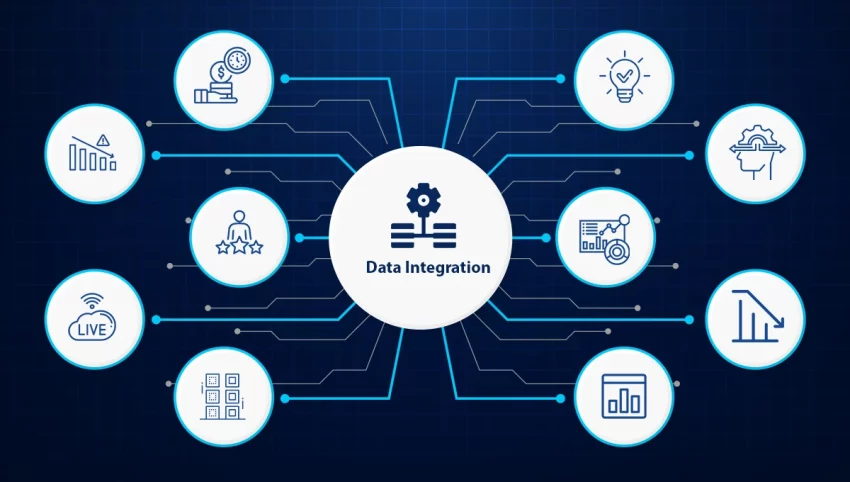An Data Integration business uses a variety of on-premises and cloud-based systems as well as hundreds of software to store data from the enterprise. Thus, data is one of the essential components that modern businesses rely on for their development. Data Integration, businesses generate massive amounts of data each second, however, if the data isn’t properly managed and integrated will not be effectively utilized. Many data points will accumulate, and then become overwhelming, leading to the requirement of the integration of data.
The process is now one of the major elements of the entire process of data governance. Companies are utilizing data integration more frequently because of the increasing demand to quickly share data that is already in use.
5 Key Features of a Successful Platform
What is Data Integration?
The process of combining data from multiple source into one, unified view is referred to as data integration. The process of ingestion begins with the ETL method that removes, transforms as well as loads information from various sources into a single view. The end result is that data integration allows analytical tools to produce valuable and useful business intelligence.
Integration of customer data is a prime illustration of this. It involves collecting data on every customer from various different business systems, like accounts, marketing as well as accounts. Then then combining the data into one view to be used in the areas of analysis, reporting and customer service.
Batch, unstructured, and streaming data may be merged using data integration to accomplish tasks that range from simple database queries for inventory to more complex predictive analytics.
Tools for data integration must include the following features:
1. Ensuring Data Quality and Integrity
Assuring the accuracy and integrity of the data gathered from different sources is essential if the company is looking to gain accurate and reliable insights from it that could provide the business with an edge in the market. Most times, the discrepancies and errors in the information gathered from the sources have to be addressed prior to it being utilized for analysis.
When data is gathered from multiple sources, a built-in quality improvement tool within the integration software allows business users to cleanse, standardize and validate the data to ensure that they are able to use high-quality data for an effective analysis.
2. Unrestricted Scalability
Concerning managing data the two main problems are scalability as well as data integration. Large corporations must handle huge amounts of data both external and internal. The flow of data within the company can sometimes shift. This requires an efficient, reliable and scalable system that is able to handle the demands of processing large amounts of information and data. The use of a flexible data integration system eliminates restrictions placed on an organization’s present or future data volumes.
3. The ability to use Data from Data Sources that aren’t normally used
The ability to combine, alter and utilize information from various sources is among the most important elements of a successful information integration software. Every type of data integration software typically support standard formats for files like SQL Server, PDF files and so on. Although data comes in from multiple sources, a lot of organizations do not have the capacity to manage the different systems that are used that can cause issues when it comes to analysis. Due to this, many businesses are now attempting to develop composable data systems together with Voltron Data or other similar companies to address this problem.
To improve your data integration process faster, it is essential to invest in a solution for data integration that can handle a variety of unconventional types of sources for data.
4. Automating and scheduling
A company’s data flow is always on the move due to the various sources, both internal and external, that it gets information from. Automatization ensures that all operations of the company have access to data without a hitch.
The system for data integration includes a job scheduler that allows business users to schedule and automate everything from basic data translation to executing complex procedures. Businesses can cut down on IT and development costs, while increasing efficiency in operations by automating routine tasks that are repetitive and time-consuming, such as updating inventories, performing regular backups, updating personal information, protecting the customer’s invoice information and much more.
5. Basic User Interface
In order to give the business user with greater control over their information flow companies are swiftly shifting to zero-code software solutions. The most current data integration software comes with drag-and-drop functionality and user-friendly interfaces that let users access information as well as capabilities without feeling intimidated by the complex technical foundations.
The user-friendly interface allows those with no computer experience to easily comprehend and understand how to use the platform for data integration. With these simple tools, companies can no longer rely on IT experts or teams of developers whenever they require data integration.
Conclusion
The efficiency and effectiveness of both analytics and operations will be enhanced by using technology for data integration to handle huge amounts of corporate data. Employees could respond to customers more quickly as well as efficiently, if they had quick access to vital data that is stored in one central location. Companies that wish to remain ahead of the competition must make investments in the development of data integration tools that facilitate the seamless unification of data from a variety of sources.
Read more:

